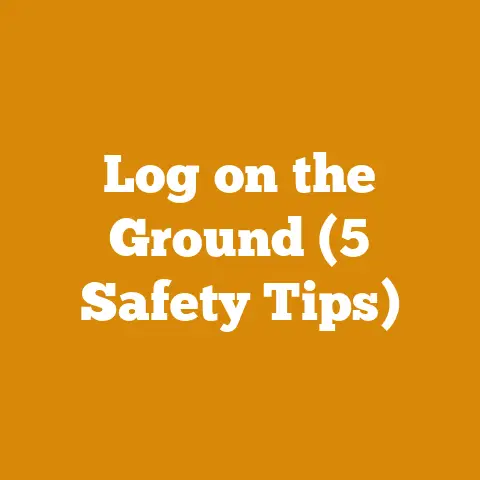New Chainsaw Chain (4 Break-In Tips)
Why do lumberjacks make great musicians?
Because they know how to handle the woodwinds!
Now that I’ve hopefully brought a smile to your face, let’s get serious about chainsaws.
If you’re like me and love the smell of fresh sawdust in the morning, you know just how important it is to have your chainsaw running perfectly.
But did you know that breaking in a new chainsaw chain is as crucial as sharpening it?
Let me take you through the process with some tips, stories, and a few laughs along the way.
Why Breaking In Matters
You might wonder why we even need to break in a chainsaw chain.
Well, think of it like new shoes.
You wouldn’t run a marathon in them right out of the box, would you?
A new chain has a protective coating and needs to adjust to the bar and engine.
Proper break-in ensures longevity and performance.
The Importance of Break-In
The break-in process allows the chain to wear evenly and settle into the bar.
This helps prevent uneven wear and tear, reducing the risk of breakage.
I remember when I first started using chainsaws; I didn’t understand this concept well.
My impatience had me pushing my new chain too hard, too fast.
The result?
A broken chain and a bruised ego.
Learning from Experience
Let me tell you about a time I learned this lesson the hard way.
I was out in the woods, eager to fell some trees for firewood.
I slapped on a new chain and went full throttle without letting it break in properly.
It was cutting like a dream until it wasn’t.
The chain snapped, nearly causing an accident.
That day taught me the importance of patience and proper technique.
Break-In Tips
Tip 1: Initial Inspection
Before you even start, give your chain a good once-over.
- Check for Defects: Look for any visible damage or irregularities.
- Ensure Proper Tension: Make sure your chain is snug but not too tight.
I’ve once ignored a nick in my chain.
Trust me, it’s not a shortcut worth taking.
Detailed Inspection Process
Take your time examining each link in the chain.
Look for any manufacturing defects or damage that might have occurred during shipping.
I once found a small crack in one of the links, which could have led to disaster if left unchecked.
Tip 2: Lubrication is Key
Proper lubrication reduces friction and heat.
- Use Quality Oil: Go for chainsaw-specific oil; they have additives to protect the chain.
- Apply Generously: Don’t skimp on oil; your chain needs to be well-coated.
I remember one time I tried to save a few bucks on oil.
Ended up with a seized bar.
Lesson learned!
Understanding Oil Types
There are different types of oils available, and using the right one can make a difference.
Some oils have additives that prevent rust, while others are designed for high-performance cutting.
Experiment with different brands to find what works best for your saw.
Tip 3: Gentle Start
Fire up that chainsaw, but take it easy at first.
- Warm Up the Engine: Let it idle for a couple of minutes.
- Cut Softwood First: Begin with softer woods to allow for smoother transitions.
- Avoid Full Throttle: Keep the RPM low during initial cuts.
I’ve found that starting with softwood is like stretching before a workout.
It prepares the chain for more demanding tasks.
Personal Experience
I remember my first gentle start with a new chain on a chilly morning.
The engine was purring like a kitten, and I began slicing through soft pine with ease.
That gentle touch helped set the chain perfectly for harder tasks later.
Tip 4: Regular Adjustments
Chains can stretch as they settle in.
- Check Tension Frequently: After every few cuts, ensure the tension is still correct.
- Retighten as Necessary: A loose chain can be dangerous.
I can’t stress enough how many times I’ve seen a loose chain fly off.
It’s not just scary; it’s hazardous.
Maintenance Routine
Developing a routine for checking tension can save you time and trouble down the road.
I usually check my tension after every fuel refill.
It becomes second nature after a while.
Safety Precautions
Safety Gear Must-Haves
- Helmet with face shield
- Cut-resistant gloves
- Steel-toed boots
- Ear protection
Safety first, folks!
I’ve had my share of close calls, and gear has saved my skin more than once.
My Safety Gear Story
One day, I forgot my ear protection at home but decided to work anyway.
A few hours later, my ears were ringing louder than church bells on Sunday morning.
Since then, I’ve never left my safety gear behind.
Warnings
Always Keep Both Hands on the Saw: Even when adjusting or inspecting.
Never Adjust While Running: Turn off the saw before making any adjustments.
Troubleshooting Tips
Chain Not Cutting Properly?
- Check Sharpness: Dull chains won’t cut well.
- Inspect Alignment: Ensure the chain is properly seated on the bar.
How to Sharpen
If your chain is dull, it’s time to sharpen it.
Get yourself a good quality file or electric sharpener and follow the manufacturer’s instructions.
I’ve found that a well-sharpened chain cuts like butter!
Excessive Vibration?
- Check Bar Mounting: Loose mounts can cause vibration.
- Examine Chain Links: Ensure none are damaged or broken.
Reducing Vibration
If vibration persists, consider using anti-vibration gloves or adding dampers to your saw.
These little additions can make your work much more comfortable.
Equipment Requirements
- Chainsaw with new chain
- Appropriate chainsaw oil
- Safety gear (helmet, gloves, boots)
- Basic tools for adjustments
Equipment Stories
I once borrowed an old chainsaw from a friend without checking if it had all its parts in place.
Midway through cutting, I realized I was missing essential tools for adjustment.
Now I double-check everything before heading out.
Prerequisite Knowledge
Before getting started, make sure you’re comfortable with:
- Basic chainsaw operation
- Identifying common parts of a chainsaw
- Understanding safety protocols
Learning Through Doing
My journey with chainsaws began as an apprentice under an experienced lumberjack.
Watching him handle his chainsaw with precision taught me more than any manual ever could.
Common Concerns Addressed
Does Break-In Affect Warranty? Generally, no.
But always check the manufacturer’s guidelines to be sure.
How Long Should Break-In Take? Usually, a few hours of varied cutting is sufficient.
Personal Experience
Manufacturers often provide guides on how to handle break-ins properly without voiding warranties.
It’s always wise to follow these guidelines closely to avoid any issues later on.
Conclusion and Next Steps
Breaking in your chainsaw chain isn’t rocket science, but doing it right can save you tons of headaches later on.
Once you’re done with the break-in process, regularly maintain your saw for optimal performance.
Happy cutting!
These simple practices can extend the life of your tools and keep them performing at their best.
FAQ
Q: Can I skip the break-in process? A: It’s not recommended.
Skipping can lead to reduced chain life and performance issues.
Q: How often should I lubricate my chain? A: Ideally, every time you refuel your chainsaw.
Q: What if my chain keeps stretching? A: Some stretching is normal initially.
If it continues excessively, inspect for defects or consider replacing it.
With these insights and experiences shared from the heart of someone who’s been there and done that, you’re now ready to handle your new chainsaw chain like a pro!
Whether you’re cutting down trees or just trimming branches, treat your chainsaw right, and it’ll serve you well for years to come.






